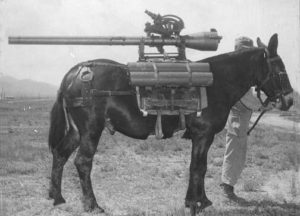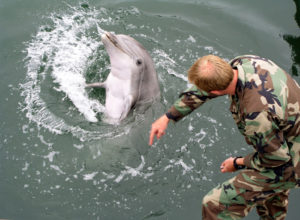By Dr. Beth Leermakers

Photo courtesy of Funny Animal Army
Animals have been used to wage wars for thousands of years. Starting in about 1500 BC, horses were first used to pull chariots in battle. Around 900 BC, warriors commonly rode horses into battle. Throughout the years, horses have played several important roles in military history, including transportation, reconnaissance missions, cavalry charges, communication and packing supplies.
Dogs were used in military combat as early as 600 BC. Military dogs were widely used by the Egyptians, Greeks and Romans. Dogs have fought alongside American troops in every conflict since the Revolutionary War, but only officially since World War II. Today, there are about 2500 American war and military service dogs, with about 700 of them serving overseas at any given time. Military working dogs are trained to detect bombs and drugs, track people and even attack
Although they’re the most common, horses and dogs aren’t the only military animals. In celebration of Memorial Day, I’ll recognize several animals who played, or were intended to play, an important role in military missions around the world:
Bats. The US military’s Project X-Ray planned to release thousands of bats armed with napalm charges in Japan. However, the plan was abandoned when some bats escaped in New Mexico, destroying a general’s car and an aircraft hangar.

Dolphins and sea lions. The U.S. and Soviet navies have used these intelligent, trainable sea mammals in their military missions. The U.S. Navy Marine Mammal Program trains bottlenose dolphins and California sea lions to detect, locate, mark and recover objects in harbors, coastal areas and at depth in the open sea. With their natural, highly sophisticated sonar, dolphins are well-equipped to locate mines and other dangerous objects that are difficult to detect with electronic sonar. Exceptional low-light vision, underwater directional hearing and the ability to dive hundreds of feet below the surface, without getting decompression sickness, make dolphins and sea lions exceptional operatives. Dolphins are trained to find and mark undersea mines that could be life-threatening to military and civilian sailors. The Navy uses dolphins and sea lions to detect and apprehend unauthorized swimmers and divers who may harm Navy personnel or ships.
The Marine Mammal Program trains sea lions to detect enemy divers and attach a tracking device to their arm or leg. Sea lions also help locate and recover crash victims and military hardware.
Parrots. During World War I, trained parrots were placed on the Eiffel Tower to warn military personnel about incoming aircraft. Unfortunately, the watch-birds couldn’t tell the difference between German and Allied planes.
Pigeons. During World War II, American behavioral scientist FB Skinner developed a plan to train pigeons to ride in missiles and guide them to enemy ships. Pigeons were trained to peck at an image of the target on a screen.
When the pecks remained in the center of the screen, the missile flew straight, but off-center pecks caused the missile to change course. Although Project Pigeon never took off, the Navy resurrected it as Project Orcon in 1948. The pigeon-guided missile project was scrapped in 1953 when electronic guidance systems were proven to be reliable.
Fleas and flies. During World War II, Japan used fleas and flies to infect China with cholera and plague. Japanese military pilots sprayed infected fleas and flies or dropped them inside bombs over major population areas. This biological warfare eventually killed about 440,000 Chinese.
Oxen. In 279 BC, a Chinese commander dressed 1000 oxen as dragons to frighten and consequently defeat an invading army. Released at the enemy camp in the middle of the night, the “dragons” created a panic among the stunned soldiers.
As I celebrate Memorial Day, I’ll pause to appreciate the soldiers — both human and animal — who’ve protected our country and saved countless lives.
Happy Memorial Day!
